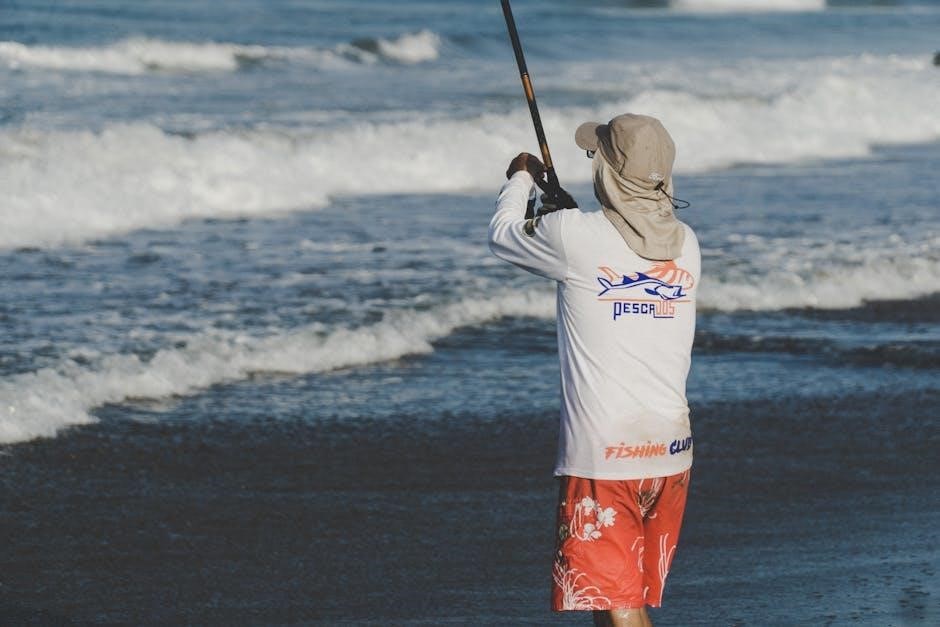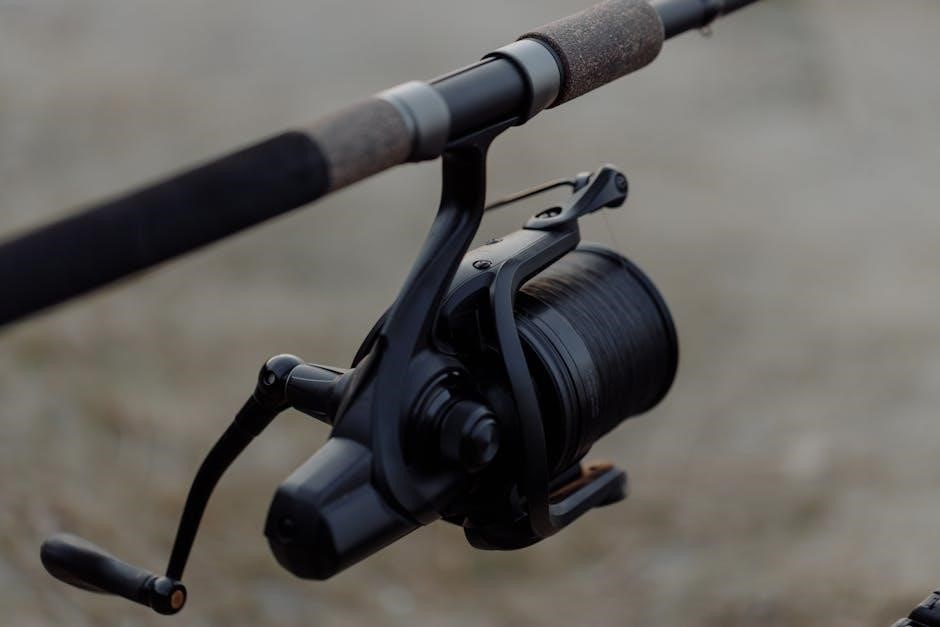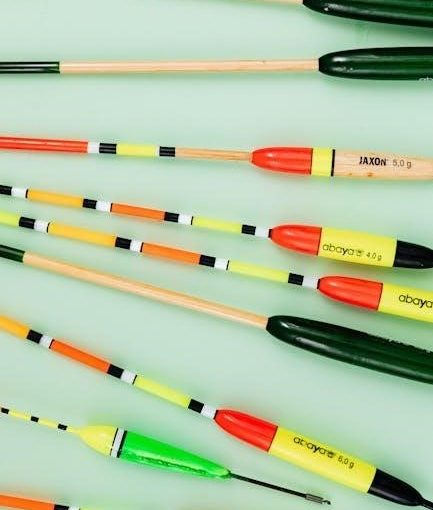Understanding the right fishing rod length is crucial for a successful angling experience. It impacts casting distance, leverage, and accuracy, ensuring you make the most of your fishing adventure. Choosing the correct length enhances both effectiveness and enjoyment, making it a key factor in your fishing setup.
1.1 Importance of Rod Length in Fishing
Rod length plays a vital role in fishing success, directly influencing casting distance, accuracy, and control. A longer rod offers greater leverage for casting farther and handling larger fish, while shorter rods provide precision and strength in tight spaces. The right length enhances sensitivity, allowing anglers to detect bites more effectively. It also impacts the balance between power and flexibility, which is crucial for various fishing techniques. Choosing the appropriate rod length ensures optimal performance, making it a cornerstone of a well-rounded fishing setup. Whether targeting small panfish or large species, rod length significantly affects the overall fishing experience and effectiveness. By selecting the correct length, anglers can maximize their chances of a successful and enjoyable outing on the water. This makes rod length a fundamental consideration for anglers of all skill levels.
1.2 Overview of Common Rod Lengths
Fishing rods come in a variety of lengths, ranging from 5 to 14 feet, each designed for specific fishing scenarios. Short rods (5-7 feet) are ideal for precise casting in tight spaces and targeting smaller species like trout or panfish. Medium rods (7-8 feet) offer versatility, making them suitable for general fishing, including bass and walleye. Longer rods (9-14 feet) are typically used for surf casting or deep-water fishing, where greater casting distance is required. The choice of rod length depends on factors such as target species, fishing technique, and the environment. Understanding these common lengths helps anglers select the right tool for their fishing needs, ensuring better performance and a more enjoyable experience on the water. This overview provides a foundation for making informed decisions when choosing a fishing rod length.

Factors Influencing Rod Length Choice
The choice of rod length is influenced by target species, fishing technique, casting distance, and accuracy requirements. Personal preference, fishing conditions, and the angler’s physical characteristics also play significant roles in selection.
2.1 Target Species and Fishing Technique
Choosing the right rod length begins with identifying your target species. For small fish like trout or panfish, shorter rods (5-7 feet) are ideal due to their precision in confined spaces. These shorter rods provide better control and leverage when handling smaller fish, making them perfect for anglers fishing in tight areas or for younger anglers who may find longer rods cumbersome. Medium rods (7-8 feet) are versatile and work well for bass, walleye, and general fishing techniques, offering a balance between casting distance and accuracy. Longer rods (9-14 feet) are best for surf casting or deep water fishing, where distance and strength are essential. The fishing technique also plays a role; for example, surf casting requires longer rods to reach distant waters, while techniques like using swimbaits for bass may benefit from a medium to long rod length. By considering both the species and the technique, anglers can select a rod length that maximizes their chances of success and enhances their overall fishing experience.
2.2 Casting Distance and Accuracy Requirements
When selecting a fishing rod, casting distance and accuracy are critical considerations. Longer rods (9-14 feet) are ideal for achieving greater casting distances, particularly in surf fishing or deep water scenarios where reaching farther is essential. These rods leverage their length to generate more power and speed during the cast, ensuring the line travels farther. For medium-distance casting, rods in the 7-8 foot range strike a balance, offering both respectable distance and precision. Shorter rods (5-7 feet) prioritize accuracy over distance, making them perfect for confined spaces or when targeting specific areas. The choice of rod length should align with the fishing environment and the angler’s technique to maximize casting performance. By matching the rod length to the required casting distance and accuracy, anglers can enhance their overall fishing efficiency and success.
2.3 Personal Preference and Fishing Conditions
Personal preference and fishing conditions play a significant role in selecting the ideal rod length. Anglers with less strength or stature may prefer shorter rods for easier handling, while taller individuals might favor longer rods for better leverage. Fishing conditions, such as wading in deep water or casting from a boat, also influence the choice. For instance, shorter rods are advantageous in tight spaces like small boats or dense vegetation, offering better control. In contrast, longer rods excel in open environments, providing the reach needed for distant casts. Additionally, the type of fishing—whether from shore, in surf, or in a kayak—dictates the appropriate rod length. Balancing personal comfort with environmental demands ensures a more enjoyable and effective fishing experience. Thus, considering these factors helps anglers choose a rod that suits their unique needs and enhances their overall performance.

Recommended Rod Lengths for Different Fishing Scenarios
Rod length varies based on fishing scenarios, with shorter rods ideal for confined spaces and longer rods suited for surf casting. Freshwater and saltwater fishing require different approaches, as do species-specific techniques. The right rod length enhances casting accuracy, leverage, and overall fishing effectiveness, ensuring anglers are prepared for any situation.

3.1 Short Rods (5-7 Feet) – Ideal for Trout, Panfish, and Confined Spaces

Short fishing rods, ranging from 5 to 7 feet, are perfect for targeting smaller species like trout and panfish. Their compact design offers precise casting control, making them ideal for confined spaces such as small streams, ponds, or tight woodland areas. These rods provide excellent leverage for handling lighter fish and are easy to maneuver in crowded environments; Additionally, shorter rods are often preferred by younger anglers or those with limited mobility, as they are lighter and simpler to manage. For beginners, a 5-7 foot rod is a great starting point, allowing them to develop their casting technique without the complexity of longer rods. Whether fishing in tight quarters or pursuing smaller game, short rods deliver both accuracy and efficiency, ensuring a rewarding fishing experience.
3.2 Medium Rods (7-8 Feet) – Versatile for Bass, Walleye, and General Use
Medium-length rods, typically between 7 and 8 feet, are highly versatile and suitable for a wide range of fishing scenarios. They offer an excellent balance between casting distance and accuracy, making them ideal for targeting species like bass and walleye. These rods are popular among anglers due to their adaptability to various fishing techniques, including bottom fishing, trolling, and casting lures. Their moderate length allows for precise control while still providing enough power to handle larger fish. Additionally, medium rods are a great choice for general use, as they perform well in both fresh and saltwater environments. Whether you’re fishing from a boat, shore, or wading, a 7-8 foot rod is a reliable option that caters to both beginners and experienced anglers, ensuring a productive and enjoyable fishing experience.
3.3 Long Rods (9-14 Feet) – Best for Surf Casting and Deep Water Fishing
Long rods, ranging from 9 to 14 feet, are ideal for surf casting and deep water fishing, where reaching great distances is essential. These rods provide exceptional casting range and leverage, making them perfect for targeting larger species in open waters. Their extended length allows anglers to cast beyond waves and cover more water, increasing the chances of landing fish like surf perch, striped bass, or halibut. Additionally, long rods are well-suited for trolling in deep water, as they offer better control over heavy lures or bait. While they may be less maneuverable in tight spaces, their performance in open environments makes them a favorite among experienced anglers. For surf casting, a 10-12 foot rod is often recommended, balancing power and sensitivity for a productive fishing experience.
Selecting the right fishing rod length enhances your fishing experience by improving casting distance, accuracy, and control. A 7-foot rod is a great starting point for most anglers, offering versatility and balance for various fishing scenarios.
4.1 Final Tips for Selecting the Right Rod Length
When choosing a fishing rod length, consider your target species, fishing technique, and the environment. Shorter rods excel in confined spaces and precise casting, while longer rods provide greater distance and leverage. For beginners, a 7-foot rod is an excellent starting point, offering versatility for various species. Test the rod’s feel and balance, as comfort enhances performance. Consider your height and casting style, as these can influence the ideal length. Ultimately, match the rod length to your fishing scenario, whether it’s trout in tight spaces or bass in open waters. Balancing these factors ensures you select a rod that enhances your fishing experience and helps you land more fish.
